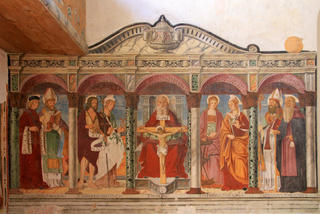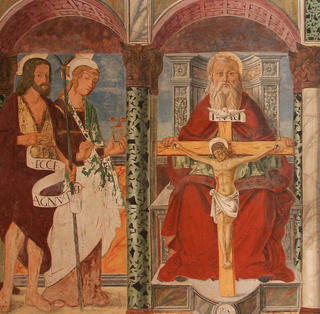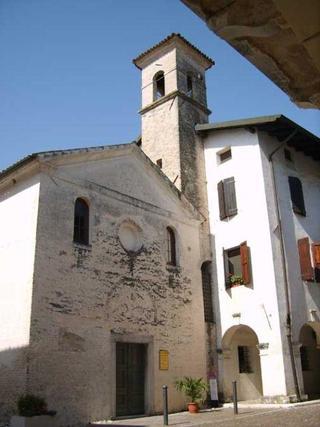
The church of Saints Peter, Paul and Anthony Abbot has been for centuries the spiritual part of a hospital, a place mainly used by wayfarers engaged in the difficult ford of the Tagliamento river.
According to a legend the “hospital” of Valvasone was allegedly established in the 10th century, but in reality the first reliable news about it date back to 1355 and tell us that it was managed by a fraternity – i.e. a lay association with solidarity intents characterised by a strong religious sentiment – most likely the one of the Battuti, the same that managed the nearby church of Saint Mary and John.

At the time the home, which coincides with the present church of St. Peter, was outside the city walls and was incorporated only in the second half of the 15th century.
What remains of this early home, surely provided with a small chapel, is a late 14thcentury or early 15th-century fresco on the counter-façade of the church, which depicts the Christ crucified between the Madonna and Saints John Evangelist, Peter and Paul, a work of art by an artist from the Giotto school, perhaps influenced by what was achieved in the nearby abbey of St. Mary in Sylvis of Sesto al Reghena.
In the 16th century the pious institute was apparently hit by a crisis due to a fall in the welfare activity of the confraternity, at least up to 1461, when it was refounded and dedicated to Saints Apostles Peter and Paul and Saints Anthony Abbot and Christopher.

Such remodernisation was set in quite a fervent period for urban planning and religious architecture in Valvasone (the cathedral was being built in the same years and the last circle
of walls was being restored), causing radical changes to the old building which took the current appearance: the home was then moved to the areas next to it and the old place became the seat of the church of St. Peter that we know today, consecrated in 1497.
The confraternity was dissolved by a Napoleon’s edict, but the home continued to operate until
the end of the 19th century when, as the charity activity was suspended, the small church became a house of prayer detached from its origins and bound to be linked to spirituality only.
The current architectural structure of the parish recreation centre is very similar to the 15thcentury one in terms of the location plan, being aisleless and with a quadrangular choir stall, whilst the height suffers from the raising of the walls of the aisle and of the presbytery, carried out in 1739: works that entailed the opening of new windows in the raised part and the ensuing walling of the previous ones (the bell tower was probably built at the same time).

Perhaps, the façade was originally adorned with the figures of the saints to whom the church is dedicated, as revealed by a faded fragment of a fresco.
Conversely, inside, the decoration remained in good state, showing what had been done around 1500 by Pietro da Vicenza, painter from the Berici Hills but quite active in the area on the Right side of the Tagliamento, influenced by the incisive graphic style by Gianfrancesco da Tolmezzo (with whom it had collaborated), to which it associates elegant antiquarian references inferred from the lesson by Mantegna.
On the left wall the artist executed a shrine, its space being partitioned by five coffered vaults, in the middle he placed the Holy Trinity (the painter's signature, represented by his initials PVP, can be read on the base), on the left Saints Bartolomeo and Biagio, John the Baptist and Lucy, whilst on the right Apollonia and Catherine, Anthony Abbot and Gotthard, each distinguished by the traditional iconographic attributes.
Along the left wall, this first shrine was sided by another one of which only two partitions remain, which survived the 18th-century construction of an altar; these two shrines portray
Saint Christopher, realistically submerged in water (evidently invoked to protect anyone
crossing the ford on the Tagliamento) and Saint Girolamus, who holds a small church bearing the crest of the Valvason family.
The works carried out by Pietro da Vicenza probably concerned the whole length of the church, on both sides, as evidenced by an additional trisected shrine, beside the high altar, with the Madonna on the throne with the Child, a minuscule praying figure on her feet (perhaps a donor), on the left Saints Sebastian and Rocco whilst Saints Leonard and Giobbe can be found on the opposite side. In this case too, as in the fragment, the space partitioned by pillars holding an architrave, with a marblelike decoration, crowned by a shell valve.
A 19th-century painting can be found on the high altar (inserted in a carved and gilded wooden frame in 1642) which portrays, in the upper part the Madonna with the Child among Saints Joseph, Agnes, Valentine and Anthony of Padua and in the lower part Saints Peter, Paul, Anthony Abbot and Andrea.
Along the walls there are two more altars executed in the 18th century: the left altar – which interrupts the fresco – has two late 15th-century polychromatic wooden statues depicting Saint Paul and Saint Anthony Abbot, parts that survived a larger polyptych; the right altar, dedicated to the Visitation of the Virgin Mary to Saint Elisabeth, houses an anonymous 17th-century
painting, in which the upper part portrays the Visitation (with the small refined insert of a sculpture portraying Moses), in the middle Saint John Evangelist holding the town of Valvasone on his knees (a rare and interesting representation where the castle and the religious building can be easily identified), at the bottom Saint Nicola da Tolentino that intercedes for the souls in Purgatory.
The church of Saint Peter, just like the cathedral, has a musical voice: a rare 17th-century positive organ (i.e. a small portable instrument) which in the 18th century was placed in a choir
stall apposite executed, where it is framed by a fresco with two cherubs holding a large curtain, and emphatic frame that seems to clash with the elegant simplicity of the small environment.




